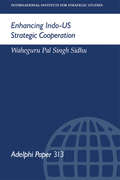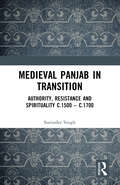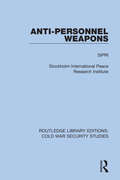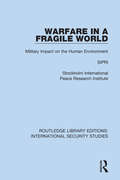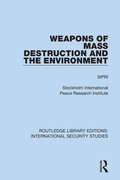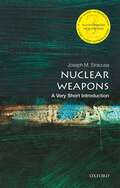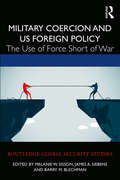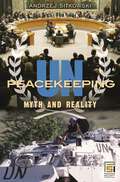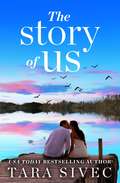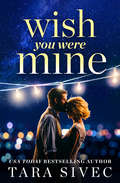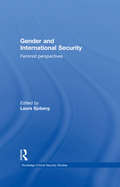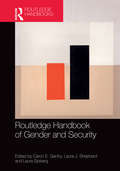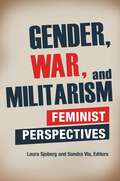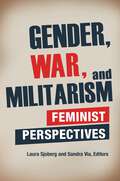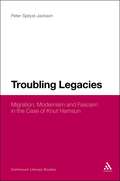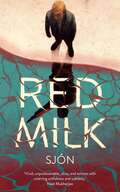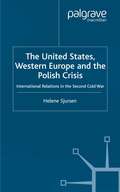- Table View
- List View
Enhancing Indo-US Strategic Cooperation (Adelphi series)
by Waheguru Pal Singh SidhuArgues that a carrot-and-stick policy is likely to be more effective than a stick-only approach in curbing India's nuclear ambitions. Increased strategic cooperation between India and the US is the ideal incentive, but the author argues that such cooperation is unlikely in the immediate future.
Medieval Panjab in Transition: Authority, Resistance and Spirituality c.1500 – c.1700
by Surinder SinghThis book reconstructs the historical transition in the undivided Panjab during the sixteenth and seventeenth centuries. It shows that the assertion of Mughal and Afghan suzerainty faced sustained resistance from local elements, particularly the autonomous tribes and hill chiefdoms. In central plains, Dulla Bhatti mobilized the toilers of his ancestral domain and, leading a relentless fight against the Mughal oppression, became an abiding symbol of resistance in the collective memory. The multicultural legacy of Panjab evolved through diverse strands of spirituality. The jogis, wedded to monastic discipline, supernatural abilities and land grants, gained acceptance through their exertions for social betterment. The Sabiri and Qadiri silsilas channelized mystical urges towards the technique of prime recitation. The popular verses of Shah Husain, Baba Lal and Sultan Bahu proposed a loving relation with God. The legendary lovers, perishing in the struggles against patriarchal forces, promoted a merger of dissent with spirituality. In the city of Lahore, the material pursuits and cultural life were visible in a mosaic of descriptions, including episodes of social tension. The book understands the upliftment of depressed castes as a defining feature of Sikhism. It places egalitarian concern of the Sikh Gurus alongside the anti-caste protests of Namdev, Kabir and Ravidas. Owing to scriptural authority and congregational equality, the members of depressed castes attained a numerical majority in the Sikh warrior bands that shook the foundations of the Mughal state. The work relies on evidence from the Persian chronicles, Mughal newsletters, Sufi writings, Sikh literature and Punjabi folklore. Please note: Taylor & Francis does not sell or distribute the Hardback in India, Pakistan, Nepal, Bhutan, Bangladesh and Sri Lanka.
Medieval Panjab in Transition: Authority, Resistance and Spirituality c.1500 – c.1700
by Surinder SinghThis book reconstructs the historical transition in the undivided Panjab during the sixteenth and seventeenth centuries. It shows that the assertion of Mughal and Afghan suzerainty faced sustained resistance from local elements, particularly the autonomous tribes and hill chiefdoms. In central plains, Dulla Bhatti mobilized the toilers of his ancestral domain and, leading a relentless fight against the Mughal oppression, became an abiding symbol of resistance in the collective memory. The multicultural legacy of Panjab evolved through diverse strands of spirituality. The jogis, wedded to monastic discipline, supernatural abilities and land grants, gained acceptance through their exertions for social betterment. The Sabiri and Qadiri silsilas channelized mystical urges towards the technique of prime recitation. The popular verses of Shah Husain, Baba Lal and Sultan Bahu proposed a loving relation with God. The legendary lovers, perishing in the struggles against patriarchal forces, promoted a merger of dissent with spirituality. In the city of Lahore, the material pursuits and cultural life were visible in a mosaic of descriptions, including episodes of social tension. The book understands the upliftment of depressed castes as a defining feature of Sikhism. It places egalitarian concern of the Sikh Gurus alongside the anti-caste protests of Namdev, Kabir and Ravidas. Owing to scriptural authority and congregational equality, the members of depressed castes attained a numerical majority in the Sikh warrior bands that shook the foundations of the Mughal state. The work relies on evidence from the Persian chronicles, Mughal newsletters, Sufi writings, Sikh literature and Punjabi folklore. Please note: Taylor & Francis does not sell or distribute the Hardback in India, Pakistan, Nepal, Bhutan, Bangladesh and Sri Lanka.
Anti-personnel Weapons (Routledge Library Editions: Cold War Security Studies #3)
by SipriThis book, first published in 1978, analyses the development, uses and effects of conventional anti-personnel weapons such as rifles and machine guns, grenades, bombs, shells and mines. It provides the historical, military, technical and clinical background to the international legal discussions as part of the ongoing efforts to prohibit or restrict the uses of some of the more inhumane and indiscriminate of these weapons, the most successful being the 1997 Ottawa Treaty that banned the use of anti-personnel mines.
Anti-personnel Weapons (Routledge Library Editions: Cold War Security Studies #3)
by SipriThis book, first published in 1978, analyses the development, uses and effects of conventional anti-personnel weapons such as rifles and machine guns, grenades, bombs, shells and mines. It provides the historical, military, technical and clinical background to the international legal discussions as part of the ongoing efforts to prohibit or restrict the uses of some of the more inhumane and indiscriminate of these weapons, the most successful being the 1997 Ottawa Treaty that banned the use of anti-personnel mines.
Warfare in a Fragile World: Military Impact on the Human Environment (Routledge Library Editions: International Security Studies #21)
by SipriThis book, first published in 1980, examines the extent to which warfare and other military activities contribute to environmental degradation. The military capability to damage the environment has escalated. The military use and abuse of each of the several major global habitats – temperate, tropical, desert, arctic, insular and oceanic – are evaluated separately in the light of the civil use and abuse of that habitat.
Warfare in a Fragile World: Military Impact on the Human Environment (Routledge Library Editions: International Security Studies #21)
by SipriThis book, first published in 1980, examines the extent to which warfare and other military activities contribute to environmental degradation. The military capability to damage the environment has escalated. The military use and abuse of each of the several major global habitats – temperate, tropical, desert, arctic, insular and oceanic – are evaluated separately in the light of the civil use and abuse of that habitat.
Weapons of Mass Destruction and the Environment (Routledge Library Editions: International Security Studies #23)
by SipriThe effects of weapons of mass destruction cannot be contained, either spatially or temporally, are unpredictable, discriminate poorly between combatants and civilians, and are highly disruptive of ecosystems. This book, first published in 1977, examines several WMD and analyses the extent and duration of environmental damage to be expected from them. Chapters are devoted to the ecological impacts of nuclear weapons, chemical and biological weapons, and geophysical and environmental weapons.
Weapons of Mass Destruction and the Environment (Routledge Library Editions: International Security Studies #23)
by SipriThe effects of weapons of mass destruction cannot be contained, either spatially or temporally, are unpredictable, discriminate poorly between combatants and civilians, and are highly disruptive of ecosystems. This book, first published in 1977, examines several WMD and analyses the extent and duration of environmental damage to be expected from them. Chapters are devoted to the ecological impacts of nuclear weapons, chemical and biological weapons, and geophysical and environmental weapons.
Nuclear Weapons: Weapons, Strategy, And Politics (Very Short Introductions)
by Joseph M. SiracusaNuclear weapons have not been used in anger since the United States dropped atomic bombs on Hiroshima and Nagasaki in August 1945. Yet even after the Cold War, the Bomb is still the greatest threat facing humankind. As President Bill Clinton's first secretary of defence, Les Aspin, put it: 'The Cold War is over, the Soviet Union is no more. But the post-Cold War world is decidedly not post-nuclear'. For all the efforts to reduce nuclear stockpiles, the Bomb is here to stay. This Very Short Introduction looks at the science of nuclear weapons and how they differ from conventional weapons. Tracing the story of the nuclear bomb, Joseph Siracusa chronicles the race to acquire the H-bomb, a thermonuclear weapon with revolutionary implications; and the history of early arms control, nuclear deterrence, and non-proliferation. He also tracks the development of nuclear weapons from the origins of the Cold War in 1945 to the end of Moscow-dominated Communism in 1991, and examines the promise and prospect of missile defence, including Ronald Reagan's 'Star Wars' and George W. Bush's National Missile Defence. This third edition includes a new chapter on the development of nuclear weapons and the policies they have generated since the end of the Cold War. ABOUT THE SERIES: The Very Short Introductions series from Oxford University Press contains hundreds of titles in almost every subject area. These pocket-sized books are the perfect way to get ahead in a new subject quickly. Our expert authors combine facts, analysis, perspective, new ideas, and enthusiasm to make interesting and challenging topics highly readable.
Nuclear Weapons: A Very Short Introduction (Very Short Introductions)
by Joseph M. SiracusaNuclear weapons have not been used in anger since the United States dropped atomic bombs on Hiroshima and Nagasaki in August 1945. Yet even after the Cold War, the Bomb is still the greatest threat facing humankind. As President Bill Clinton's first secretary of defence, Les Aspin, put it: 'The Cold War is over, the Soviet Union is no more. But the post-Cold War world is decidedly not post-nuclear'. For all the efforts to reduce nuclear stockpiles, the Bomb is here to stay. This Very Short Introduction looks at the science of nuclear weapons and how they differ from conventional weapons. Tracing the story of the nuclear bomb, Joseph Siracusa chronicles the race to acquire the H-bomb, a thermonuclear weapon with revolutionary implications; and the history of early arms control, nuclear deterrence, and non-proliferation. He also tracks the development of nuclear weapons from the origins of the Cold War in 1945 to the end of Moscow-dominated Communism in 1991, and examines the promise and prospect of missile defence, including Ronald Reagan's 'Star Wars' and George W. Bush's National Missile Defence. This third edition includes a new chapter on the development of nuclear weapons and the policies they have generated since the end of the Cold War. ABOUT THE SERIES: The Very Short Introductions series from Oxford University Press contains hundreds of titles in almost every subject area. These pocket-sized books are the perfect way to get ahead in a new subject quickly. Our expert authors combine facts, analysis, perspective, new ideas, and enthusiasm to make interesting and challenging topics highly readable.
Military Coercion and US Foreign Policy: The Use of Force Short of War (Routledge Global Security Studies)
by Melanie W. SissonThis book examines the use of military force as a coercive tool by the United States, using lessons drawn from the post-Cold War era (1991–2018). The volume reveals that despite its status as sole superpower during the post-Cold War period, US efforts to coerce other states failed as often as they succeeded. In the coming decades, the United States will face states that are more capable and creative, willing to challenge its interests and able to take advantage of missteps and vulnerabilities. By using lessons derived from in-depth case studies and statistical analysis of an original dataset of more than 100 coercive incidents in the post-Cold War era, this book generates insight into how the US military can be used to achieve policy goals. Specifically, it provides guidance about the ways in which, and the conditions under which, the US armed forces can work in concert with economic and diplomatic elements of US power to create effective coercive strategies. This book will be of interest to students of US national security, US foreign policy, strategic studies and International Relations in general.
Military Coercion and US Foreign Policy: The Use of Force Short of War (Routledge Global Security Studies)
by Melanie W. Sisson James A. Siebens Barry M. BlechmanThis book examines the use of military force as a coercive tool by the United States, using lessons drawn from the post-Cold War era (1991–2018). The volume reveals that despite its status as sole superpower during the post-Cold War period, US efforts to coerce other states failed as often as they succeeded. In the coming decades, the United States will face states that are more capable and creative, willing to challenge its interests and able to take advantage of missteps and vulnerabilities. By using lessons derived from in-depth case studies and statistical analysis of an original dataset of more than 100 coercive incidents in the post-Cold War era, this book generates insight into how the US military can be used to achieve policy goals. Specifically, it provides guidance about the ways in which, and the conditions under which, the US armed forces can work in concert with economic and diplomatic elements of US power to create effective coercive strategies. This book will be of interest to students of US national security, US foreign policy, strategic studies and International Relations in general.
UN Peacekeeping: Myth and Reality (Praeger Security International)
by Andrzej SitkowskiIn this book, Andrzej Sitkowski confronts two basic peacekeeping myths. First, the belief that peacekeeping is separate from peace enforcement blurs this difference and undermines the viability of peacekeeping operations. Secondly, it is widely believed that the peacekeepers are allowed to apply force only in self-defense and lack the authorization to use it in defending UN Security Councils mandates. Solidly anchored in official primary sources originating from the UN, national governments, parliamentary inquiries (Dutch, French, and Belgian) and from the International Criminal Tribunal on Rwanda, this book integrates the most recent recommendations related to peacekeeping. It exposes how the UN peacekeeping syndrome of soldiers safety first crept into the NATO's strategy and compromises its missions in Kosovo and Afghanistan.The peacekeeping system has largely outlived its usefulness and is bound to fail when applied to currently predominant violent and messy conflagrations. Lacking radical changes in that system, the UN should disarm, restricting the peacekeeping to military observers' missions and to subcontracting other operations out to military alliances and regional organizations. The widely lamented massacres of innocent civilians under UN Peacekeeper eyes in Rwanda, Srebrenica, and the Congo influenced neither the UN's approach nor the analysis of the methods. In this book, Andrzej Sitkowski confronts two basic peacekeeping myths. First, the belief that peacekeeping is distinct from peace enforcement blurs this distinction and undermines the viability of peacekeeping operations. In fact, it is the UN's definition of self-defense, which is understood to include actions of troops against forceful obstructions to discharging their mandates, that confuses the issue. Nevertheless, that distinction remains a cornerstone of the UN doctrine. Secondly, it is widely believed that the peacekeepers are allowed to apply force only in self-defense and lack the authorization to use it in defending UN Security Councils mandates. This myth persists, even in cases when the UN Security Council undertakes explicit authorization to enforce specific goals of the mandate.Sitkowski offers a critical re-appraisal of the fundamental principles of peacekeeping, including both the largest successes (Namibia) and worst disasters (Rwanda). Drawing heavily on personal accounts, the book is solidly anchored in official primary sources originating from the UN, national governments, parliamentary inquiries (Dutch, French and Belgian) and from the International Criminal Tribunal on Rwanda. It integrates the most recent recommendations related to peacekeeping originating from High-Level Panels and endorsed by Kofi Annan. Finally it exposes how the UN peacekeeping syndrome of soldiers safety first crept into the NATO's strategy and compromises its missions in Kosovo and Afghanistan.
The Story of Us: A heart-wrenching story that will make you believe in true love
by Tara SivecFrom the USA Today bestselling author of Fisher's Light comes a "heartbreaking and hopeful" (AL Jackson) standalone romance about first love and second chances. How much can a man take before he breaks?1,843 days. That's how long I survived in that hellhole. They tried to break me, but I resisted. And I owe it all to the memory of warm summer nights, the scent of peaches, and the one woman who loved me more than I ever deserved to be loved. Now, I'll do anything to get back to her. Only Shelby Eubanks isn't the girl I left behind all those years ago. She's someone else, a stranger. My Shelby-my little green-eyed firecracker-would never give up her dreams, would never disappear into her mother's ambitions. But I won't give up on her. On us. I may be broken, and scarred, and not the man I used to be, but I will do whatever it takes to remind her of the story of us.
Wish You Were Mine: A heart-wrenching story about first loves and second chances
by Tara SivecFrom the USA Today bestselling author of The Story of Us and Fisher's Light comes a new, standalone novel - a heartwrenching story about second chances that will make you fall in love all over again.Five years. I would've stayed away longer if I hadn't received the letter. Not a day has gone by that I haven't thought about her, haven't missed her smile, haven't wished that things were different.The last time I saw my two best friends, I vowed to not stand in the way of their happiness, even if that meant I couldn't be a part of their lives. Cameron James and her emerald-green eyes were too much of a temptation and I couldn't stay and watch them together. Cameron deserved better than me. She deserved him.But now that I am back, things are different. I'm not going to stand by and watch the woman I've always loved slip away again. I'm done living my life with regrets and I'm ready to tell her the truth. And I'll do whatever it takes to show her that I always wished she was mine.
Gender and International Security: Feminist Perspectives (Routledge Critical Security Studies #17)
by Laura SjobergThis book defines the relationship between gender and international security, analyzing and critiquing international security theory and practice from a gendered perspective. Gender issues have an important place in the international security landscape, but have been neglected both in the theory and practice of international security. The passage and implementation of UN Security Council Resolution 1325 (on Security Council operations), the integration of gender concerns into peacekeeping, the management of refugees, post-conflict disarmament and reintegration and protection for non-combatants in times of war shows the increasing importance of gender sensitivity for actors on all fronts in global security. This book aims to improve the quality and quantity of conversations between feminist security studies and security studies more generally, in order to demonstrate the importance of gender analysis to the study of international security, and to expand the feminist research program in Security Studies. The chapters included in this book not only challenge the assumed irrelevance of gender, they argue that gender is not a subsection of security studies to be compartmentalized or briefly considered as a side issue. Rather, the contributors argue that gender is conceptually, empirically, and normatively essential to studying international security. They do so by critiquing and reconstructing key concepts of and theories in international security, by looking for the increasingly complex roles women play as security actors, and by looking at various contemporary security issues through gendered lenses. Together, these chapters make the case that accurate, rigorous, and ethical scholarship of international security cannot be produced without taking account of women’s presence in or the gendering of world politics. This book will be of interest to all students of critical security studies, gender studies and International Relations in general. Laura Sjoberg is Assistant Professor of Political Science at the University of Florida. She has a Phd in International Relations and Gender Studies from the University of Southern California and is the author of Gender, Justice, and the Wars in Iraq (2006) and, with Caron Gentry, Mothers, Monsters, Whores: Women's Violence in Global Politics (2007)
Gender and International Security: Feminist Perspectives (Routledge Critical Security Studies)
by Laura SjobergThis book defines the relationship between gender and international security, analyzing and critiquing international security theory and practice from a gendered perspective. Gender issues have an important place in the international security landscape, but have been neglected both in the theory and practice of international security. The passage and implementation of UN Security Council Resolution 1325 (on Security Council operations), the integration of gender concerns into peacekeeping, the management of refugees, post-conflict disarmament and reintegration and protection for non-combatants in times of war shows the increasing importance of gender sensitivity for actors on all fronts in global security. This book aims to improve the quality and quantity of conversations between feminist security studies and security studies more generally, in order to demonstrate the importance of gender analysis to the study of international security, and to expand the feminist research program in Security Studies. The chapters included in this book not only challenge the assumed irrelevance of gender, they argue that gender is not a subsection of security studies to be compartmentalized or briefly considered as a side issue. Rather, the contributors argue that gender is conceptually, empirically, and normatively essential to studying international security. They do so by critiquing and reconstructing key concepts of and theories in international security, by looking for the increasingly complex roles women play as security actors, and by looking at various contemporary security issues through gendered lenses. Together, these chapters make the case that accurate, rigorous, and ethical scholarship of international security cannot be produced without taking account of women’s presence in or the gendering of world politics. This book will be of interest to all students of critical security studies, gender studies and International Relations in general. Laura Sjoberg is Assistant Professor of Political Science at the University of Florida. She has a Phd in International Relations and Gender Studies from the University of Southern California and is the author of Gender, Justice, and the Wars in Iraq (2006) and, with Caron Gentry, Mothers, Monsters, Whores: Women's Violence in Global Politics (2007)
Routledge Handbook of Gender and Security
by Laura Sjoberg Laura J. Shepherd Caron E. GentryThis handbook provides a comprehensive look at the study of gender and security in global politics. The volume is based on the core argument that gender is conceptually necessary to thinking about central questions of security; analytically important for thinking about cause and effect in security; and politically important for considering possibilities of making the world better in the future. Contributions to the volume look at various aspects of studying gender and security through diverse lenses that engage diverse feminisms, with diverse policy concerns, and working with diverse theoretical contributions from scholars of security more broadly. It is grouped into four thematic sections: Gendered approaches to security (including theoretical, conceptual, and methodological approaches); Gendered insecurities in global politics (including the ways insecurity in global politics is distributed and read on the basis of gender); Gendered practices of security (including how policy practice and theory work together, or do not); Gendered security institutions (across a wide variety of spaces and places in global politics). This handbook will be of great interest to students of gender studies, security studies and IR in general.
Routledge Handbook of Gender and Security
by Laura Sjoberg Laura J. Shepherd Caron E. GentryThis handbook provides a comprehensive look at the study of gender and security in global politics. The volume is based on the core argument that gender is conceptually necessary to thinking about central questions of security; analytically important for thinking about cause and effect in security; and politically important for considering possibilities of making the world better in the future. Contributions to the volume look at various aspects of studying gender and security through diverse lenses that engage diverse feminisms, with diverse policy concerns, and working with diverse theoretical contributions from scholars of security more broadly. It is grouped into four thematic sections: Gendered approaches to security (including theoretical, conceptual, and methodological approaches); Gendered insecurities in global politics (including the ways insecurity in global politics is distributed and read on the basis of gender); Gendered practices of security (including how policy practice and theory work together, or do not); Gendered security institutions (across a wide variety of spaces and places in global politics). This handbook will be of great interest to students of gender studies, security studies and IR in general.
Gender, War, and Militarism: Feminist Perspectives (Praeger Security International)
by Laura Sjoberg Sandra ViaThis compelling, interdisciplinary compilation of essays documents the extensive, intersubjective relationships between gender, war, and militarism in 21st-century global politics.Feminist scholars have long contended that war and militarism are fundamentally gendered. Gender, War, and Militarism: Feminist Perspectives provides empirical evidence, theoretical innovation, and interdisciplinary conversation on the topic, while explicitly—and uniquely—considering the links between gender, war, and militarism. Essentially an interdisciplinary conversation between scholars studying gender in political science, anthropology, and sociology, the essays here all turn their attention to the same questions. How are war and militarism gendered?Seventeen innovative explanations of different intersections of the gendering of global politics and global conflict examine the theoretical relationship between gender, militarization, and security; the deployment of gender and sexuality in times of conflict; sexual violence in war and conflict; post-conflict reconstruction; and gender and militarism in media and literary accounts of war. Together, these essays make a coherent argument that reveals that, although it takes different forms, gendering is a constant feature of 21st-century militarism.
Gender, War, and Militarism: Feminist Perspectives (Praeger Security International)
by Laura Sjoberg Sandra E. ViaThis compelling, interdisciplinary compilation of essays documents the extensive, intersubjective relationships between gender, war, and militarism in 21st-century global politics.Feminist scholars have long contended that war and militarism are fundamentally gendered. Gender, War, and Militarism: Feminist Perspectives provides empirical evidence, theoretical innovation, and interdisciplinary conversation on the topic, while explicitly—and uniquely—considering the links between gender, war, and militarism. Essentially an interdisciplinary conversation between scholars studying gender in political science, anthropology, and sociology, the essays here all turn their attention to the same questions. How are war and militarism gendered?Seventeen innovative explanations of different intersections of the gendering of global politics and global conflict examine the theoretical relationship between gender, militarization, and security; the deployment of gender and sexuality in times of conflict; sexual violence in war and conflict; post-conflict reconstruction; and gender and militarism in media and literary accounts of war. Together, these essays make a coherent argument that reveals that, although it takes different forms, gendering is a constant feature of 21st-century militarism.
Troubling Legacies: Migration, Modernism and Fascism in the Case of Knut Hamsun (Continuum Literary Studies)
by Peter Sjølyst-JacksonModernist troublemaker in the 1890s, Nobel Prize winner in 1920, and indefensible Nazi sympathiser in the 1930s and 40s, Knut Hamsun continues to provoke condemnation, apologia and critical confusion. Informed by the works of Jacques Derrida and Sigmund Freud, Troubling Legacies analyses the heterogeneous and conflicted legacies of the enigmatic European writer, Hamsun. Moving through different phases of his life, this study emphasises the dislocated nature of Hamsun's works and the diverse and conflicting responses his fiction elicited from such figures as Franz Kafka, Katherine Mansfield, Walter Benjamin and Martin Heidegger. Close readings of the major novels Hunger, Mysteries, Pan and Growth of the Soil are presented alongside lesser known writings, including his early polemic on America, his turn-of-the-century travelogue through Russia, his fascist polemics of the 1930s and 40s, and his controversial post-war testimony, On Overgrown Paths. Troubling Legacies links past debates with contemporary literary theory and deconstruction in a way that contributes to critical thinking about political responsibility.
Red Milk
by Sjón'A book like a blade of light, searching out and illuminating the darkest corners of history . . . It's vivid, unputdownable, alive, and written with unerring artfulness and subtlety.' Neel MukherjeeGunnar Kampen grows up in Iceland during the Second World War in a household fiercely opposed to Hitler and Nazism. At nineteen he seems set for a conventional, dutiful life. And yet in the spring of 1958, he founds a covert, anti-Semitic nationalist party, a cause that will take him on a clandestine mission to England from which he never returns. Inspired by one of the ringleaders of a little-known neo-Nazi group that was formed in Iceland in the 1950s, Sjón's portrait of an ardent fascist is as thought-provoking as it is disturbing. As this taut and fascinating novel suggests, the seeds of extremism can be hard to detect - and the ideology of the far-right remains dangerously potent.
The United States, Western Europe and the Polish Crisis: International Relations in the Second Cold War (Cold War History)
by H. SjursenThis book examines the response of the Western Alliance to the Polish Crisis (1980-83). The author analyses the different views of Europe and the United States regarding enforcement in East-West relations and the opposition in Western Europe to the American approach. This case exemplifies the lasting differences in attitude within the Western Alliance.
